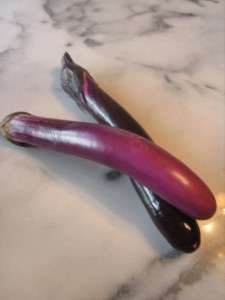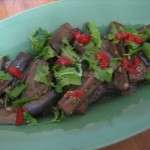 It’s time to eat eggplant. In northern California, I find Chinese and Japanese eggplants are the best in the summer and early fall. Look for the freshest in farmers’ markets or try Asian grocery stores. Unlike the large plump, rounded pear-shaped eggplant favored by North Americans, both these Asian varieties are slender. They contain few seeds and hold their shape when cooked.
It’s time to eat eggplant. In northern California, I find Chinese and Japanese eggplants are the best in the summer and early fall. Look for the freshest in farmers’ markets or try Asian grocery stores. Unlike the large plump, rounded pear-shaped eggplant favored by North Americans, both these Asian varieties are slender. They contain few seeds and hold their shape when cooked.
Chinese eggplants may grow to more than twelve inches long with a smooth lavender to dark purple skin. Japanese varieties tend to be shorter with a blackish-purple skin. Because these Asian varieties are less seedy, their flesh feels creamier and smoother when cooked. When stir-fried or braised, the pieces hold together, especially when attached to the skin, rather then collapse into a shapeless mass.
Eggplants act like sponges. They soak up the flavor of the seasonings and foods they are cooked with. This characteristic makes them highly versatile.
Try them in braised dishes such as Braised Eggplant, Pork, and Mushrooms on page 93 of The Hakka Cookbook or view a food video of the recipe at grokker.com
 In Garlic-Chile Eggplant Sticks, page 56 to 57, the soy-braised eggplant sticks maintain their shape. Serve them as a cool or hot first course or vegetable dish. Consider them for a cool appetizer for a hot summer evening.
In Garlic-Chile Eggplant Sticks, page 56 to 57, the soy-braised eggplant sticks maintain their shape. Serve them as a cool or hot first course or vegetable dish. Consider them for a cool appetizer for a hot summer evening.
The slender eggplant can be sliced into short sections, split in the center and filled, so they somewhat resemble  eggplant sandwiches. Use your favorite filling or try this one. In the Singapore Stuffed Vegetable and Tofu Soup, page 106, pan-brown these pork and fish-filled eggplant sandwiches, then poach in broth with other filled vegetables and tofu.
eggplant sandwiches. Use your favorite filling or try this one. In the Singapore Stuffed Vegetable and Tofu Soup, page 106, pan-brown these pork and fish-filled eggplant sandwiches, then poach in broth with other filled vegetables and tofu.
Although you can often find Asian eggplants year round in Asian supermarkets, try them now while they are in season to get the freshest and best quality. They should be firm with shiny skin.

